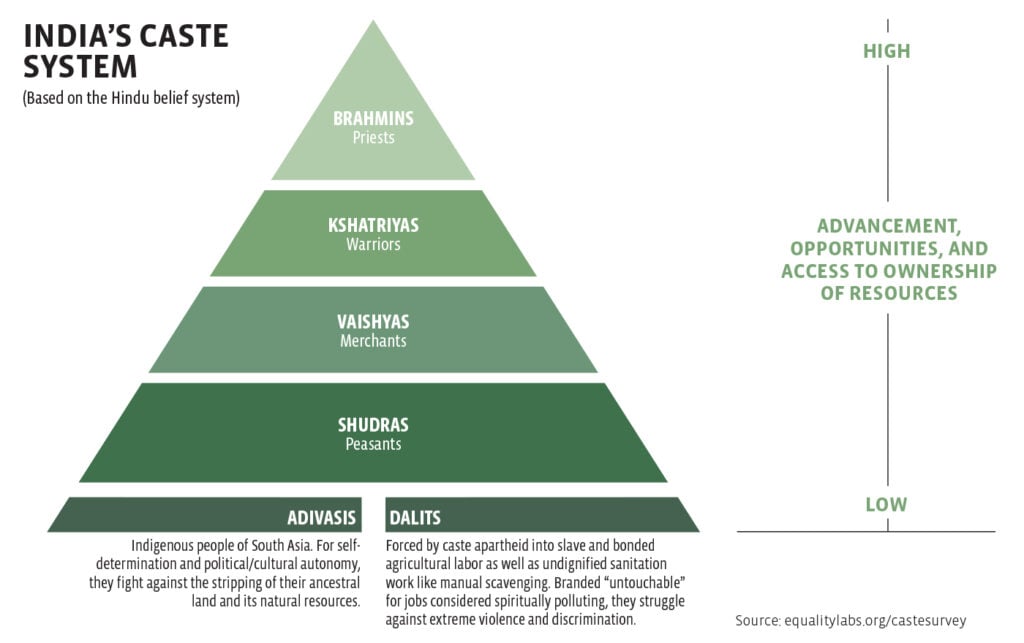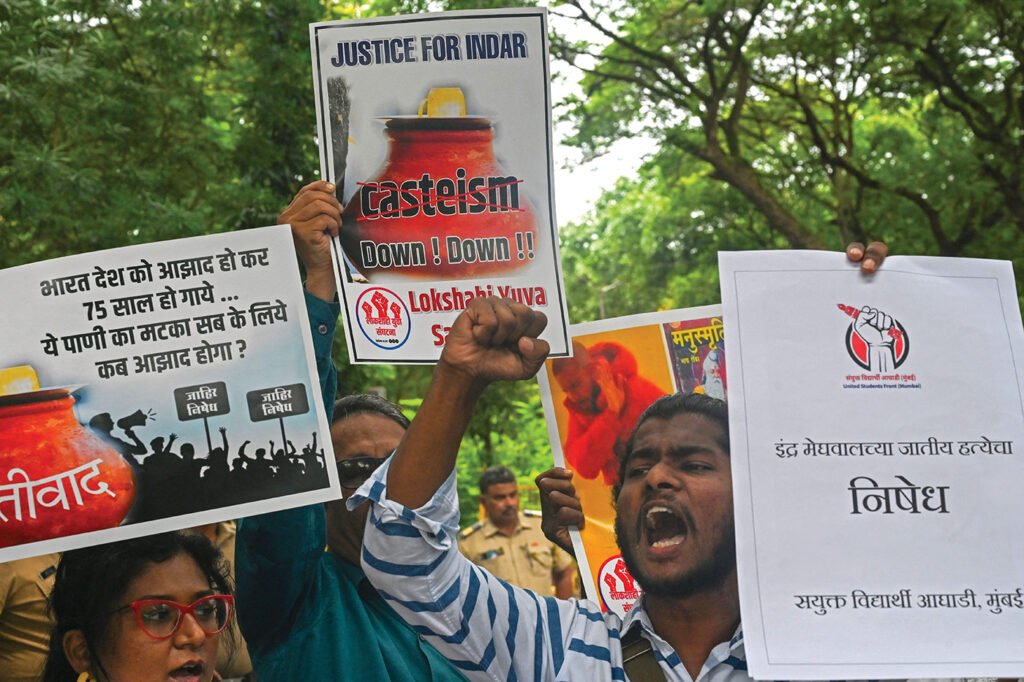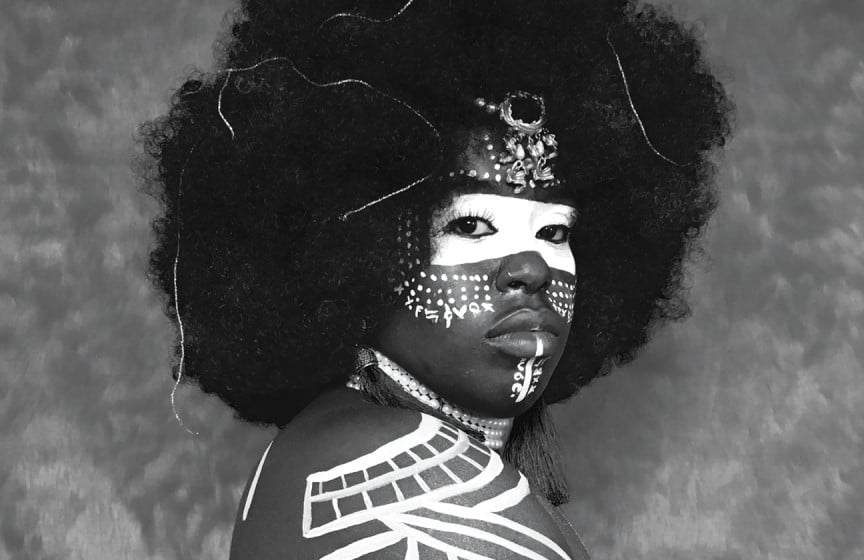Bodies: Culture Shift
- Confronting Caste
- Share

Confronting Caste
A Dalit American leader offers a profound meditation on the violence of caste apartheid, pathways to abolition, and collective healing.

If we stand next to one another, Thenmozhi Soundararajan and I look alike. We both have Indian immigrant roots and are the products of marriages between Hindu fathers and Christian mothers. We share similar brown skin, dark hair, and multisyllabic names. But while Soundararajan’s childhood was marked by the trauma of discovering she hails from the lowest rung of India’s caste system, mine was free of caste trauma because I was born into a family with a Brahmin name.
In The Trauma of Caste: A Dalit Feminist Meditation on Survivorship, Healing, and Abolition, Soundararajan explores the searing experience of navigating and resisting one of the world’s oldest and largest genocidal social orders. “Caste apartheid,” as she aptly calls it, is rarely spoken of outside India and is “centuries older than race.”

Caste Is Built Into Hinduism
Many Westerners are seduced by the mystical India portrayed in the 2010 Julia Roberts film Eat Pray Love, which chronicled a white woman’s spiritual quest. Concepts like karma (fate) and dharma (duty) have become buzzwords in the West, offering a promise of salvation.
In fact, Hinduism privileges a Brahmin minority of priests and intellectuals at the top of a rigid social pyramid. Just below them are Kshatriyas, society’s rulers and warriors. Next in line are Vaishyas, the merchants and traders, and then Shudras, who perform menial work. In the proverbial basement of Hindu society are so-called “scheduled castes.” They’re the multitudes of people who were once labeled “untouchables” and are today known by their self-proclaimed identity, “Dalits.” The further down the caste pyramid one is born, the less pure one is deemed.
Soundararajan explains that Dalits like her are “those people whose touch, breath, or mere presence is a pollution” to the Brahmin sensibility. Hindu scripture relegates Dalits to a lifetime of scavenging for survival and cleaning the human waste of the upper castes. This humiliation is considered penance for sins committed in a previous life, and only through obedient subjugation can Dalits redeem their souls and be reincarnated into a higher caste.
There’s a tendency among some defenders of caste apartheid, such as Rajiv Malhotra, author of Breaking India: Western Interventions in Dravidian and Dalit Faultlines, to claim that British occupiers invented caste oppression in India. It’s tempting to buy into an idea of shared victimhood at the hands of colonizers. But Soundararajan quotes one damning verse of ancient Hindu scripture after another, written well before the British occupied India, prescribing sadistic and grossly specific torture as punishment for violating caste hierarchy. Lower-caste people were meant to have iron nails driven into their mouths, hot oil poured into their mouths and ears, or have their tongues cut off for merely speaking arrogantly to Brahmins.
From the Manusmriti to the Bhagavad Gita, the inviolability of caste-based subjugation is an undeniable prerequisite for Hindu spiritual practices. Worse, it offers a blank check for modern-day caste violence, which remains alive and well in the decades since the British were kicked out of India. Today, while there are millions of Dalits living all over South Asia, including in Nepal, Sri Lanka, Pakistan, and Bangladesh, the vast majority—more than 200 million—live in India.
Incidents of caste-based violence aimed at Indian Dalits, such as lynching, scalping, beheading, police brutality, and assault, are routine. Dalit women, struggling to survive at the intersection of caste- and gender-based oppression, face shocking levels of sexual violence. According to the Indian government, an average of 10 Dalit women and girls are raped each day—considered to be a gross underestimate. Meanwhile, Prime Minister Narendra Modi’s government has enacted a terrifying citizenship test designed to disenfranchise Dalits, Muslims, and anyone whose existence represents a threat to Brahmanical patriarchy.
Detention camps for those who will be deemed stateless have already been built, forming part of what Soundararajan calls “the world’s largest genocidal project to date.” Such violence in India remains largely invisible to the international community simply because it isn’t reported within a framework of caste oppression. It’s akin to the U.S. media reporting on police brutality without any mention of the race of victims and perpetrators. The silence multiplies the violence.

The Trauma of Caste Oppression
Soundararajan’s parents emigrated to the United States in the 1970s as part of a wave of Dalits who benefited from hard-won affirmative action policies. They found to their dismay that other Indian immigrants had brought caste-based beliefs with them. Soundararajan’s parents subsequently lived in Southern California as a “minority within a minority,” disguising their last name for years to hide an ancestry considered to be spiritually polluted.
Born in the U.S., Soundararajan discovered her family’s caste when she was only 10. She wondered as a child what she had apparently done in her past life to be “convicted as filthy and unclean in this one,” and harbored thoughts like “I don’t think I’m untouchable. I don’t feel it, but you know, if I deserve it, I want to know.”
In an interview, Soundararajan shared with me how as an adult she thought about “what it means for you to be ripped away from the right to be able to have an existential reality and purpose in the world, and a relationship to the divine that’s on your own terms.” She concluded, “It’s a tremendous level of dehumanization.” The discovery that one is at the bottom of a predetermined fictional hierarchy written into ancient texts, from which there is no hope for redemption (at least in one’s current lifetime), is gut-wrenching. It’s a trauma that Soundararajan explores with powerful grace in her book, inviting us to feel her pain moving through our own skin, flesh, and bones. “Imagine what it might feel like to be told your womb is a curse,” she writes.
Identifying Caste Privilege
Although my last name identifies me as a Hindu Brahmin, my Catholic mother is among India’s religious minorities who sought refuge in faiths where caste isn’t woven into scripture. Her original caste remains unknown—a fact I took pride in as a young critic of the caste system. My father, however, in spite of being born into a communist household that rejected religion altogether, has routinely and casually referred to caste for as long as I can remember.
He does so in ways that appear trivial, merely an exercise in curiosity to identify fellow Indians by their surnames. So-and-so is a jaath-walla, he says, meaning they are a fellow caste member. The word jaath in my mother tongue of Marathi is one I heard often as a child but rarely linked to caste. After all, my liberal family, formed by an interfaith marriage and embracing an atheistic worldview, always rejected the idea of Brahmins as superior beings.
But in practice, my father often expresses an undercurrent of pride in identifying his ancestral background not just as Brahmin, but as a sub-caste called “Konkanastha Brahmins,” hailing from the Konkan region of Maharashtra. There’s even a sexy acronym: Kobras. Kobras, identifiable to one another by their last names, rely upon networks of jaath-wallas for help with jobs, education, housing, employment, and more—in India and in immigrant diasporas. This is how Brahmins—a mere 5% of Hindus—have remained at the top of the caste pyramid. Such privilege remains invisible, especially to non-Hindus.
While my family forcefully rejects the idea that Dalits are in any way inferior to us, we have undoubtedly benefited from caste privilege. My last name—one that I retained with feminist pride after marriage—has always identified me to other Kobras as a jaath-walla, whether I wanted it to or not, making me a beneficiary of a system whose violence I struggle to comprehend.
Wherever Hindus emigrate, they import caste hierarchies to their new home countries. It’s no surprise that South Asian enclaves preserve caste apartheid. In 2020, the state of California sued Cisco Systems for allowing a Dalit tech worker to be harassed by upper-caste Hindu employees in Silicon Valley. Soundararajan’s book is an invitation for caste-privileged South Asians like me to interrogate our relationship to one another and to those who are caste-oppressed. Even as we identify as racial minorities in the U.S., our positions of entitlement within the ancient pyramid of Hindu supremacy comes with a responsibility to dismantle it. “Think about claiming caste as a way to abolish it,” she advises.
Healing From Caste Oppression
How does one end a system of violence—or heal from it—when there is so much silence surrounding it? “The yearning for global empathy is something I feel deeply in my body,” Soundararajan writes. She has found a powerful source of empathy among those who have suffered racial injustices in the U.S., writing, “Dalits stand with our Black kin, as we suffer from similar historical violence and state impunity for generations.” Referring to Hindu hierarchy as “caste slavery,” she draws parallels between the struggles of Dalits and those of Black Americans in the U.S.
But those similarities are complicated by a painful fact—that we South Asians have committed caste-based violence for millennia against our own kind. Tarana Burke, the founder of the #metoo movement, identifies this in her foreword to Soundararajan’s book: “When I was talking about it with my staff, one of the things that was difficult for us to grapple with is what would happen if violence like racism came from our own people.”
“It requires great will to take on the gravity of who you are in the face of a society that insists you are not equal, and therefore not human,” writes Soundararajan. She has developed that will through her adopted faith of Buddhism, a religion that many see as having stemmed from a rejection of caste. At the back of her book, readers will find somatic exercises inspired by practitioners like Resmaa Menakem and Ruth King as a way to move through the grief of caste oppression and to imagine a “caste-liberated future” as a path for healing and, ultimately, abolition.
Soundararajan is optimistic about a future where there can be solidarity among South Asians of different castes, saying, “We can move past the horror. We can look at the discomfort of the violence that this system has done to us and use the discomfort as a door. Use it as a door to acknowledge all that we’ve lost but also to know not everything is lost yet, that we still have each other. Being able to know that we have each other is still a gift.”


